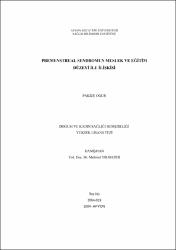| dc.contributor.advisor | Yılmazer, Mehmet | |
| dc.contributor.author | Oğur, Pakize | |
| dc.date.accessioned | 2015-05-11T07:58:54Z | |
| dc.date.available | 2015-05-11T07:58:54Z | |
| dc.date.issued | 2004 | |
| dc.date.submitted | 2004 | |
| dc.identifier.uri | http://hdl.handle.net/11630/4025 | |
| dc.description.abstract | Premenstrual sendrom (PMS), menstruel siklusun luteal fazı esnasında ortaya çıkan, duygusal ve fiziksel semptomlarla karakterize, genç ve orta yaş kadınlarda yaygın olarak görülen menstruel siklus rahatsızlığıdır.
Araştırma, çalışan hemşire ve öğretmenlerde iş stresinin PMS üzerindeki etkisini araştırmak ve çalışan bayanlarla ev hanımlarını PMS görülme oranı açısından karşılaştırmak amacıyla tanımlayıcı olarak planlanmıştır.
Araştırmanın örneklemini 129 öğretmen, 144 hemşire ve 134 ev hanımı oluşturmuş olup, veri toplama aracı olarak demoğrafik tanıtım formu, Baltaşlar tarafından geliştirilen iş stresi ölçeği ve Gençdoğan tarafından geliştirilen PMS ölçeği kullanılmıştır.
İstatistiksel analizlerde yüzdelik, iki ortalama arasındaki önem kontrolünde t testi, Anova Varyans Analizi, Kruskal Wallis Varyans Analizi, Mann Whitney U ve Ki kare analizleri kullanılmıştır.
Araştırma sonucunda hemşirelerin %55.6’sında, öğretmenlerin %62.0’sinde, ev hanımlarının %38.1’inde PMS saptanmış olup çalışan bayanlarda PMS görülme oranı ev hanımlarından oldukça yüksektir. İş stresi düzeyi açısından karşılaştırıldığında ise iş stres puanı hemşire grubunda öğretmenlere oranla daha yüksek bulunmuştur.
İş stres puanı sağlık açısından riskli düzeyde olan hemşirelerde PMS görülme oranı %66.2, öğretmenlerde %79.3 olarak tespit edilmiştir.
Araştırmadan elde edilen bulgular sonucunda, iş stresinin PMS üzerinde etkili olduğu, çalışan bayanlarda daha fazla sorun yaşandığı saptanmıştır. | en_US |
| dc.description.abstract | Premenstrual syndrom (PMS) is a disease emerging as a menstrual cycles common among young and middle aged women, which occurs in the luteal phase of menstrual cycles characterized by emotional and physical symptoms.
The aim of this study searching the effect of work stress on PMS and comparing the working women with housewives in terms of PMS frequency in a descriptive approach.
The samples of the study are 129 teachers, 144 nurses 134 housewives. The data are collected through demograpfic introductory form, the scale of work stress devoloped by Baltaslar and PMS scala by Gencdogan.
Anova Variation Analysis, t test, Kruskal Wallıs Variation Analysis, Mann Whitney U and Chi square test are used in the statistical analysis of the study.
As a result of the study, it is found out that 55.6% of nurses, 62.0% of the teachers and 38.1% of the housewives are observed with PMS. The percentage of working women with PMS is much higher than that of housewives. According to the work stress level, the percantege of work stress level of nurses is higher than that of teachers’.
The rate of PMS the nurses with risky level in terms of the health, work stress point is 66.2 % and the rate for the teachers is 79.3%.
This study shows that the effect on work stress is observed and working women tend to face more problems. | en_US |
| dc.language.iso | tur | en_US |
| dc.publisher | Afyon Kocatepe Üniversitesi, Sağlık Bilimleri Enstitüsü | en_US |
| dc.rights | info:eu-repo/semantics/openAccess | en_US |
| dc.subject | Çalışan Bayan | en_US |
| dc.subject | Ev Hanımı | en_US |
| dc.subject | Eğitim Düzeyi | en_US |
| dc.subject | İş Stresi | en_US |
| dc.subject | Premenstrual Sendrom | en_US |
| dc.title | Premenstrual Sendromun Meslek ve Eğitim Düzeyi ile İlişkisi | en_US |
| dc.title.alternative | The Relation Between Premenstrual Syndrom and the Level of Occupation and Education | en_US |
| dc.type | masterThesis | en_US |
| dc.department | Afyon Kocatepe Üniversitesi, Sağlık Bilimleri Enstitüsü, Doğum ve Kadın Hastalıkları Hemşireliği Bölümü | en_US |
| dc.relation.publicationcategory | Tez | en_US |



















